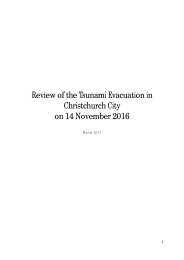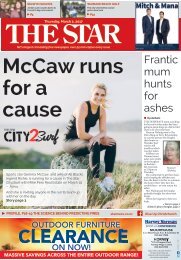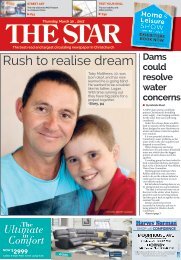117075cs
You also want an ePaper? Increase the reach of your titles
YUMPU automatically turns print PDFs into web optimized ePapers that Google loves.
16 Thursday March 16 2017<br />
Latest Christchurch news at www. .kiwi<br />
The Star<br />
News<br />
EXCITING: White flippered penguins have started expanding<br />
their nesting spots on Banks Peninsula. <br />
Pest control allows penguins<br />
to roam further on peninsula<br />
• By Bridget Rutherford<br />
A SUCCESSFUL predator<br />
control programme on Banks<br />
Peninsula has meant some of<br />
the world’s smallest penguins<br />
have started exploring<br />
new nesting sites.<br />
In November and December,<br />
Banks Peninsula<br />
Conservation Trust<br />
carried out its great<br />
little penguin count at<br />
the largest mainland<br />
penguin colony in the<br />
country – Flea Bay.<br />
It is carried out every four<br />
years on the white flippered<br />
penguins and took about three<br />
weeks to do, because they like<br />
to nest in isolated, and difficult<br />
spots to access.<br />
Although the number of<br />
pairs of penguins had declined<br />
since the previous count, results<br />
showed they have started<br />
to explore old and unused nest<br />
sites.<br />
Nests were found in burrows<br />
at Otanerito, which had been<br />
unused for about 15-20 years.<br />
BPCT Wildside co-ordinator<br />
Marie Haley said it was<br />
exciting news for the colony’s<br />
future.<br />
She said it showed the success<br />
of the predator control<br />
programme across an area<br />
known as the Wildside, since<br />
numbers blew out in the 1980s.<br />
The Wildside is a nationally<br />
significant area for the protection<br />
of sea bird breeding sites.<br />
Marie Haley<br />
“It’s taken that long for<br />
the programme to be good<br />
enough, and long enough lasting<br />
for the tide to really turn<br />
and it’s quite exciting.”<br />
Ms Haley said the penguins<br />
had also been nesting at<br />
the bottom of Hinewai<br />
Reserve, and also<br />
around the coast where<br />
the predator control<br />
programme took place,<br />
from Akaroa head to Le<br />
Bons Bay.<br />
They had also moved<br />
to more open places<br />
closer to humans and activity,<br />
and seemed to be coping well,<br />
she said.<br />
A lot more were also being<br />
spotted in Akaroa Harbour,<br />
she said.<br />
In 2012, 1304 penguin pairs<br />
were counted. While the recent<br />
count found 1250.<br />
Ms Haley said the drop<br />
was not concerning, because<br />
the Flea Bay population had<br />
increased most years, and now<br />
it seemed to have reached its<br />
maximum.<br />
The very first count was<br />
done in 2000, with 717 pairs.<br />
The trust was also seeing<br />
continued increase in<br />
the number of sooty shearwaters<br />
or titi, nesting at Stony<br />
Bay.<br />
In the last count in December,<br />
there were up to 50 chicks.<br />
The number had gone up every<br />
year.















